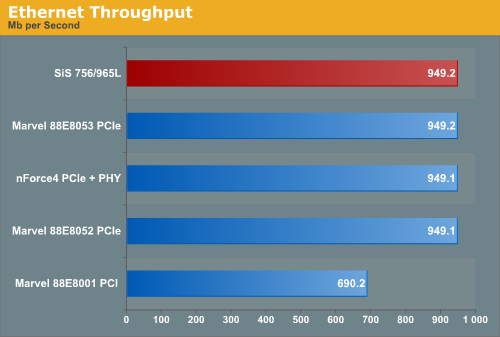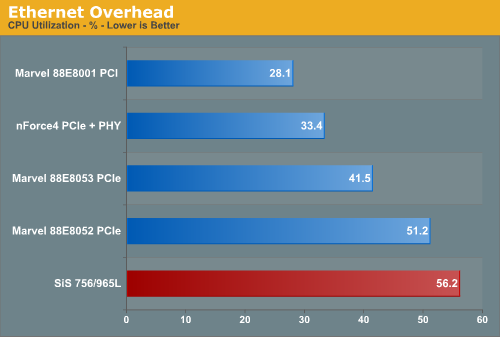SiS 756: PCI Express for AMD Socket 939
by Wesley Fink on September 13, 2005 12:05 AM EST- Posted in
- CPUs
Ethernet Performance
The new motherboard test suite, launched earlier this year, includes LAN performance measurements. The test procedure that we use was first described in a VIA white paper.
The Windows 2000 Driver Development Kit (DDK) includes a useful LAN testing utility called NTttcp. We used the NTttcp tool to test Ethernet throughput and the CPU utilization of the various Ethernet Controllers used on the various nForce4 and ATI motherboards. We did not test the ULi M1695/M1567 Ethernet controller since ULi only provides 10/100 performance on their LAN controller.
We set up one machine as the server; in this case, an Intel box with an Intel CSA Gigabit LAN connection. Intel CSA has a reputation for providing fast throughput and this seemed to be a reasonable choice to serve our Gigabit LAN clients. At the server side, we used the following Command Line as suggested by the VIA whitepaper on LAN testing:
Please keep in mind that CPU utilization measurements for Gigabit Ethernet can be somewhat misleading, since they measure the percentage of CPU tie-up at sustained Gigabit receiving. In reality, it would be very rare that you would actually see sustained Gigabit transmission levels on your PC. For that reason, you should put the measured CPU utilization of Gigabit PCIe LAN in perspective. It will almost always be much lower than what we have measured.
The new motherboard test suite, launched earlier this year, includes LAN performance measurements. The test procedure that we use was first described in a VIA white paper.
The Windows 2000 Driver Development Kit (DDK) includes a useful LAN testing utility called NTttcp. We used the NTttcp tool to test Ethernet throughput and the CPU utilization of the various Ethernet Controllers used on the various nForce4 and ATI motherboards. We did not test the ULi M1695/M1567 Ethernet controller since ULi only provides 10/100 performance on their LAN controller.
We set up one machine as the server; in this case, an Intel box with an Intel CSA Gigabit LAN connection. Intel CSA has a reputation for providing fast throughput and this seemed to be a reasonable choice to serve our Gigabit LAN clients. At the server side, we used the following Command Line as suggested by the VIA whitepaper on LAN testing:
NTttcps -m 4 ,0,On the client side (the motherboard under test), we used the following Command Line:-a 4 -l 256000 -n 30000
NTttcpr - m 4 ,0,At the conclusion of the test, we captured the throughput and CPU utilization figures from the client screen.-a 4 - l 256000 - n 30000


Please keep in mind that CPU utilization measurements for Gigabit Ethernet can be somewhat misleading, since they measure the percentage of CPU tie-up at sustained Gigabit receiving. In reality, it would be very rare that you would actually see sustained Gigabit transmission levels on your PC. For that reason, you should put the measured CPU utilization of Gigabit PCIe LAN in perspective. It will almost always be much lower than what we have measured.










31 Comments
View All Comments
PrinceGaz - Tuesday, September 13, 2005 - link
Yeah, after hearing in an earlier comments section here about all the problems with ActiveArmor and checking on the relevant forums, I decided against it. Then I found that nVidia's IDE/SATA drivers are also notorious, and for me they made it impossible to load Windows after installing, so I have to unselect them when installing the chipset driver and just stick with the standadrd Windows ones. That's with the 6.66 driver that was the latest when I last checked.nVidia really need to sort their chipset drivers out, they may make good hardware but that is useless if the software to make it works is bug-ridden.
nserra - Tuesday, September 13, 2005 - link
Well always criticizing about the mobos doesn’t do more than 220Mhz/230Mhz, but when do you test this?When I will see some nforce3 Ultra/ULi M1695 doing 300Mhz or more on Sempron(2600+/2800+)/Athlon(3000+) to test how good are they for overclocking?
I mean this AMD Athlon 64 4000+ (2.4GHz) Socket 939 is useless to know this (i think).
When i will see a 2600 sempron going from 1.6Ghz go to 2.6Ghz? Or Athlon 1.8Ghz going 2.4Ghz or more.
How good are this new mobos that can do 400Mhz like Uli? I mean I need more HTT speed to overclock more right?
1.6Ghz (200Mhz) vs 2.4Ghz (300Mhz) vs [3.2Ghz (400Mhz)|Impossible]
Only Xbit does real OC tests on the web, not just theorical ones?
Wesley Fink - Tuesday, September 13, 2005 - link
The 4000+ we use for testing OC is known to OC as high as 245 on some motherboards. Our test memory has gone as high as 318 at 1:1 on some motherboards, by lowering the CPU multiplier. If there are other factors, like no memory voltage adjustments, we will also lower the memory divider (and performance) to determine the highest clock frequency OC. By lowering the memory ratio our CPU/memory has done as high as 400 Clock frequency on some boards. With this envelope of known OC values with this CPU and memory we test each motherboard we review. This provides real information on overclocking capabilities COMPARED to other motherboards.A "review" with just one set of numbers, whether overclocking or benchmarks, is nothing more than an advertisement. A REVIEW requires comparison of the SAME EXACT TESTS on two or more boards, IMO. Picking memory ratios out of the air for OC tests will generate high OC numbers, but those numbers tell you nothing about overclocking performance compared to other boards.
nserra - Tuesday, September 13, 2005 - link
OK. I though you would need an FX processor to do that.Wesley Fink - Tuesday, September 13, 2005 - link
All Athlon64 processors are unlocked DOWN (below the rated multiplier). On a 4000+, 12X is the stock multiplier, but you can select 12x, 11x, 10x, 9x, 8X on if the motherboard supports multipliers (and almost all A64 motherboards do). The FX is unlocked UP and DOWN , so you can also select higher multipliers like 13x, 14x, etc. with an FX53 which also runs at 12x like the 4000+.The down unlock is really a by-product of Cool'n'Quiet, as AMD implements cool'n'quiet as a drop to lower multipliers when overheating occurs.
Palek - Tuesday, September 13, 2005 - link
On page 5 in the memory stress testing section:"This points to SiS having a poorer front end to the ATI on-chip memory controller than either nForce4 or ATI Rx480."
That should be AMD on-chip memory controller.
Wesley Fink - Tuesday, September 13, 2005 - link
How right you are. Corrected . . .Furen - Tuesday, September 13, 2005 - link
Horrible... I guess all those 300+HTT mobos have me spoiled.hermitthefrog - Tuesday, September 13, 2005 - link
It just makes me wonder because the average person who normally buys an off-the-shelf doesn't care if it is a socket 754 or 939 or whatever, as these things don't mean much except to the gamers and power users that would typically build their own systems. SiS usually seems to cater to the OEM systems where the PC manufacturer is more concerned about a price point and basic performance and the end-user doesn't care what chipset is in his machine. All he cares about is probably "Well it a Pentium 4 or it is 3000 mhz" or whatever because this is obvious. So if SiS is going to bother to make a chipset to compete with the NForce 4 they should realize what makes the NForce 4 so popular- ever since the NForce2, gamers and the like have associated Nforce with top performance and cutting edge features. And obviously the Nforce 4 is better than the Nforce 2 or 3! I know some of my friends and I who used to have Athlon XP's and Nforce 2 based boards would naturally love to get our hands on the latest and greatest Nforce 4/Athlon 64 systems because to us it is a sure thing and it has a cool name to boot. Meanwhile ATI and SiS and VIA all have cryptic chipset names that don't elicit an emotional response like the "NForce" did. I guess the point I am trying to make is that Nvidia's competitors are not as marketable, and the products aren't as "edgy or daring" sounding and this is why they are all getting trounced sales-wise (production and design and availability problems ahem non-withstanding) and the fact that Nvidia actually delivers when they say they will. I am not a fan boy but this is all obvious from watching for the couple years.ceefka - Tuesday, September 13, 2005 - link
Plus you'd be hardpressed to find the features of the nF4 on another chipset. While SiS, ATI, VIA and ULi may be getting there, they offer just about nothing that you can't get from an nF4.